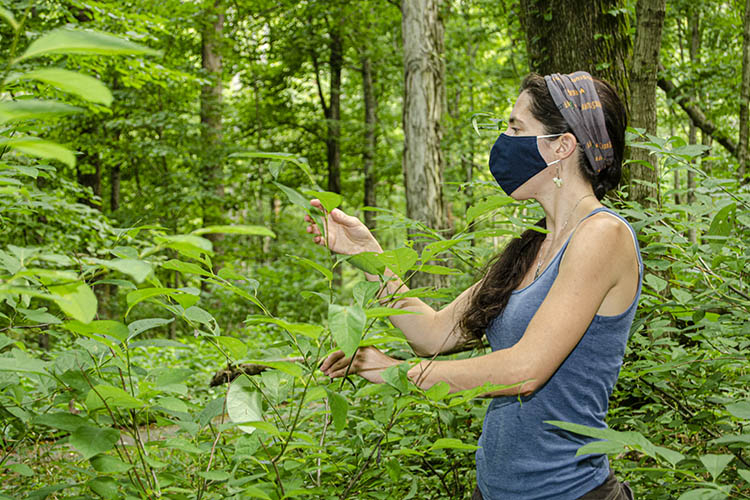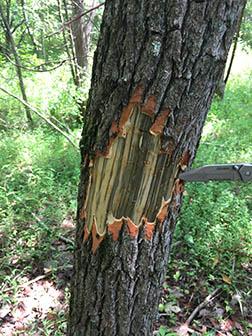UK Forestry and Natural Resources studies newest invader in Kentucky forests
UK Forestry and Natural Resources studies newest invader in Kentucky forests

LEXINGTON, Ky., — Megan Buland bent over a spicebush in Floracliff Nature Sanctuary, looking for the elusive spicebush swallowtail caterpillar in its tiniest larval stage. Buland, a forest health technician with the University of Kentucky College of Agriculture, Food and Environment, is getting a baseline count this summer as part of a study on the effects of the fungal disease, laurel wilt, which has invaded the state.
“Sassafras and spicebush are the primary food sources that we have here in our state for spicebush swallowtail caterpillars. Laurel wilt might have direct impacts on these caterpillar populations,” said Buland, who works in the UK Department of Forestry and Natural Resources. “When we started looking into available information on these caterpillars, there’s not a lot out there. We didn’t know what their populations looked like. We didn’t know there are gaps between generations; in July we don’t see any caterpillars, but in August the next generation begins to emerge. This is why we monitor, to form a picture of these populations.”
Laurel wilt is caused by an invasive fungal pathogen from Asia, Raffaelea lauricola. The disease has recently been discovered in Christian, Todd and Logan counties in Kentucky and neighboring counties in Tennessee. Spread by the tiny redbay ambrosia beetle, also an invasive species from Asia, it affects species of the laurel family (Lauraceae), which include redbay, sassafras, spicebush and avocado. In this area, the sassafras tree and the spicebush shrub, both native species, are at risk. Mountain laurel is not affected, because, despite its name, it is not a member of the laurel family. Until now, laurel wilt has been primarily restricted to Florida and Georgia, but lately, it leapt northward, likely through the movement of firewood or plant life from the coastal south.
“The first detection of it was last summer,” said Ellen Crocker, UK assistant professor of forest health extension. “It’s probably been there a little bit before that, because trees were already dying.”
This is not good news in a state that has already experienced a major die-off of ash, an important timber tree, and hemlock, an ecologically vital tree, from the invasive insect pests emerald ash borer and hemlock woolly adelgid, respectively. Tree death from laurel wilt results rapidly and the infection may be caused by introduction from a single beetle. While sassafras is not valued as a timber species and, at times, spicebush can grow into a dense and problematic understory, their value to the native ecosystem has yet to be fully determined. Spicebush, for example, is a good alternative to invasive plants, such as bush honeysuckle, burning bush and privet, that can negatively impact woodlands.
“Sassafras represents about 1% of the trees in the state, but it and spicebush both produce fruit that is valued by wildlife,” Crocker said. “We’re trying to determine what impact laurel wilt is going to have on biodiversity and on other things in our woods.”
Buland is gathering data at Floracliff in Fayette County and on woodland property near Frankfort. The pilot project will help her design future studies on caterpillar populations.
Independent of the spicebush swallowtail study, the UK forest health extension program is working with foresters in Western Kentucky and researchers throughout the Southeast to scout for trees that seem to be resistant to the disease.

Black streaks under the bark of a sassafras tree are an indication of laurel wilt disease. Photo by Abe Nielsen, Ky. Division of Forestry
Crocker asks woodland owners to be on the lookout for the disease in their stands and report any sightings to their county agricultural and natural resources extension agent. Laurel wilt symptoms include sudden wilting and discoloration of the foliage, followed by rapid leaf death. Initially, the tree may exhibit signs that resemble drought or water stress. Dead sassafras leaves appear reddish-brown in color and remain attached to plants for up to two weeks. A unique sign of laurel wilt is distinctive black streaking in the sapwood directly beneath the bark.
No management options are currently available for laurel wilt, so limiting the movement of infected wood is critical to limit disease spread. Crocker urges landowners to avoid transporting firewood or debris from infected trees or from species susceptible to laurel wilt. If laurel wilt is suspected, contact a local county extension office, http://extension.ca.uky.edu/county.
Extension Forestry & Natural Resources Research

